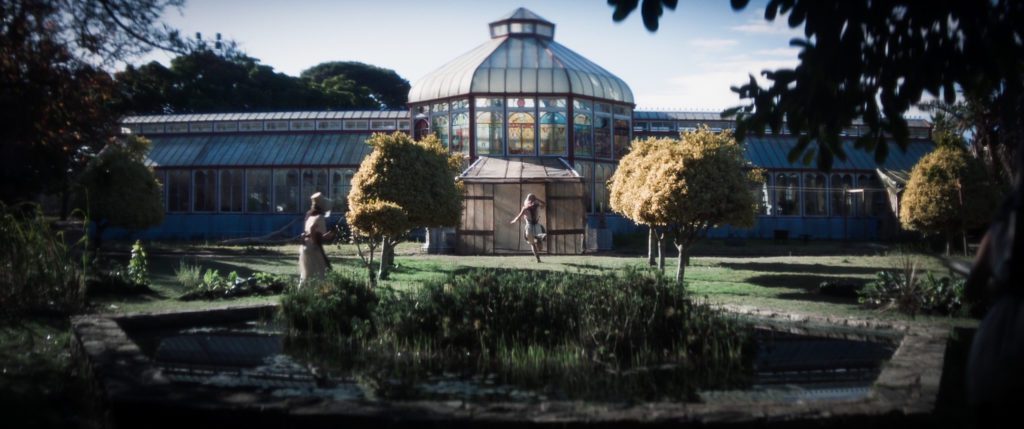The late Victorian glass structure of the Pearson Conservatory (built in 1882) stamps the landscape of the South African Eastern Cape with a reminder of British colonialism—and it makes one magnificent main set location for writer-director Kelsey Egan’s Glasshouse.
In fact, it’s the film’s only location. A pandemic film in both production timeline and thematic material, Glasshouse is set in an unmarked future where an airborne disease colloquially referred to as the Shred erodes memories and causes dementia. The Pearson Conservatory is “The Sanctuary” for a family of five. The mother (Adrienne Pearce), with a haircut seemingly exported from an M. Night Shyamalan movie, imposes religious rituals upon her four children to keep their memories alive and functional. The most important of all rituals? Everything in the sanctuary is sacred and nobody from the outside may enter. This is set off-balanced when the eldest daughter, Bee (Jessica Alexander), lets in the Stranger (Hilton Pelser). Now that he is inside the sanctuary, is he not sacred?
The Victorian-era costume and production design, in addition to the plot, obviously force allusions to Sofia Coppola’s The Beguiled. But others have commented about that to great lengths, including the official Fantastic Fest synopsis. Unlike the French-Turkish director Deniz Gamze Ergüven’s Mustang, which intentionally and curiously toyed with Coppola’s The Virgin Suicides by importing the story to a different cultural setting to make sharp political commentary, Egan’s attempt feels more ode-ish. Even the way she lights and colors scenes—overwashing the screen with angelic whites—is reminiscent of Coppola’s work. The problem is there seems to be no larger purpose to this inspirational feeling other than to communicate a deep love for the work that inspired her. Why does the family wear Victorian clothes despite being set in the future, as opposed to Coppola’s antebellum past? Perhaps it’s my own lack of imagination (I also didn’t like the similarly designed Cowboys & Aliens), but the sci-fi elements of The Shred just didn’t work with the period-piece aesthetics.
Another film I was reminded of was Dan Trachtenberg’s anxiety-fest 10 Cloverfield Lane. Of course, like The Beguiled, Egan’s film is set in a shelter-adjacent location where the outside cannot come inside. In Trachtenberg’s film, though, viewers weren’t sure how earnest the outside threat was (at least, as someone completely new to the Cloverfield franchise, I wasn’t). John Goodman’s Howard may have been a serial kidnapper and/or sex trafficker or the alien threat may be real. The juggling of the evidence for both options was at the crux of the film’s production of anxiety.
I thought Glasshouse was going to do something similar. Might the Shed be a maternal lie to keep the mother’s daughters with her? Are some people unaffected? Egan and Emma Lungiswa de Wet’s screenplay even teases such possibilities. The Stranger arrives without fear of the outside and exits the glasshouse unharmed a few times without one of the mandatory masks. The ending likewise approaches this thematic material, but without the same awareness of the potential for anxiety. A few more tweaks in this respect and I might have actually felt the feelings the sci-fi horror/thriller movie intended me to.
I suspect the real-life pandemic is what inclined the screenwriters to not delve into the outside-inside truthfulness debate of 10 Cloverfield Lane. “Covid truthers” are a crazy lot of conspiratorial mind-zombies who just don’t deserve a possible plot parallel to positively identify with. Roland Emmerich’s new release Moonfall provides an example of a similar gesture to outer-space conspiratorial thinkers, and it makes for one of the weakest screenplays of the year thanks to an amazing ignorance about the events of the world since 2016. Perhaps the filmmakers were attempting to be faithfully politically correct, an understandable directorial decision even if it doesn’t work out as generously on the artistic level.
But then again, it’s not like Glasshouse makes any grand political statements the other way around. In an interview with Flip Screened, Egan pointed to the intended political allegory of South African colonialism, but it just isn’t there:
It’s very much that but it’s also informed by this vestige of horror, which is really the haunting, permeating quality of colonialism in Africa. That’s the last Victorian glasshouse left standing—a gift from the UK—and it’s this relic of colonialism in this very contemporary South African context, right? So the whole film ended up becoming this allegory for colonialism: You have this beautiful facade, but there’s rot underneath seeping through.
Sure, religion plays a particularly devious role, as it did in apartheid, in the formation of the family’s insular community that even toys with incest. But religion also played a key role in ending apartheid. There isn’t any redemption available for religion in Glasshouse. Most importantly, the Stranger—and everyone else in the film—is white. If the filmmakers think this passes for a South African political allegory about colonialism, I’m not sure they fully understood the colonial situation. And with Egan originally hailing from Wisconsin, perhaps they don’t.
Glasshouse
2022
dir. Kelsey Egan
94 min.
Glasshouse will be available on VOD starting 7/12.



